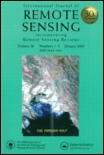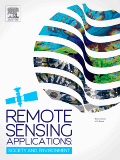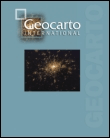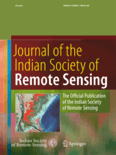
INTERNATIONAL JOURNAL OF REMOTE SENSING
Scope & Guideline
Unveiling the Secrets of Our Planet from Above
Introduction
Aims and Scopes
- Remote Sensing Technology Development:
The journal publishes research on the advancement of remote sensing technologies, including satellite, aerial, and ground-based systems, with a focus on sensor innovation, data acquisition, and processing techniques. - Environmental Monitoring and Management:
Research addressing environmental challenges such as deforestation, land degradation, climate change, and urbanization, utilizing remote sensing data for monitoring and management purposes. - Agricultural and Land Use Studies:
Papers frequently explore applications in agriculture, including crop monitoring, precision agriculture, land use classification, and food security assessments using remote sensing data. - Climate and Atmospheric Studies:
The journal covers studies related to climate monitoring, atmospheric phenomena, and their interactions with land and water resources, leveraging remote sensing for data collection and analysis. - Disaster Management and Risk Assessment:
Research focusing on the use of remote sensing for disaster risk assessment, response, and recovery, including studies on floods, wildfires, and other natural disasters. - Data Fusion and Machine Learning Applications:
The integration of remote sensing data with machine learning techniques for enhanced analysis, classification, and prediction across various applications.
Trending and Emerging
- Machine Learning and AI in Remote Sensing:
There is a significant increase in research applying machine learning and artificial intelligence techniques to remote sensing data analysis, enhancing classification, prediction, and interpretation capabilities. - Multi-Source Data Integration:
Emerging themes focus on the integration of data from multiple sources, including satellite, UAV, and ground-based observations, to provide more comprehensive analyses and insights. - High-Resolution Remote Sensing Applications:
An upward trend in studies utilizing high-resolution remote sensing data for applications in urban planning, environmental monitoring, and precision agriculture is evident, reflecting the growing availability of such data. - Time-Series Analysis and Monitoring:
Papers focusing on time-series analysis for monitoring environmental changes, land use dynamics, and vegetation health are increasingly common, emphasizing the need for continuous monitoring. - Remote Sensing for Biodiversity and Ecosystem Studies:
Research exploring the use of remote sensing in assessing biodiversity, ecosystem health, and conservation efforts is gaining momentum, driven by the need for effective environmental management strategies.
Declining or Waning
- Traditional Land Cover Mapping Techniques:
There is a noticeable decline in the publication of papers focusing on conventional land cover mapping methods, as newer approaches utilizing advanced machine learning and remote sensing technologies gain traction. - Single-Sensor Remote Sensing Studies:
Research limited to single-sensor data analysis has decreased, with a shift towards multi-sensor approaches that integrate various data sources for comprehensive insights. - Static Environmental Assessments:
Papers that provide static assessments of environmental conditions are becoming less common, as there is a growing preference for dynamic, time-series analyses that capture changes over time. - Basic Remote Sensing Algorithms:
The publication of studies focusing solely on basic remote sensing algorithms without innovative applications or enhancements has declined, reflecting a shift towards more complex and application-driven research.
Similar Journals

International Journal of Engineering and Geosciences
Pioneering research at the forefront of geosciences and engineering.The International Journal of Engineering and Geosciences, with ISSN 2548-0960, is a premier academic journal published by Selcuk University Press, specializing in the interrelated fields of engineering and geosciences. Established as an Open Access resource in 2016, the journal aims to enhance the dissemination of research, fostering collaboration and innovation within the scientific community. Based in Turkey, this journal serves as a vital platform for researchers and professionals to share their findings and contribute to the advancement of knowledge in environmental science and related disciplines. With an impressive Q2 category ranking in the field of Environmental Science (miscellaneous) for 2023, it ranks #81 out of 219 in Scopus, placing it in the 63rd percentile. The journal not only acknowledges transformative research trends from 2019 to 2024 but also emphasizes the importance of sustainability and environmental stewardship in engineering practices, making it an indispensable resource for students, researchers, and professionals passionate about the intersection of these disciplines.

Revista de Teledeteccion
Unlocking the potential of remote sensing methodologies.Revista de Teledeteccion, published by UNIV POLITECNICA VALENCIA, EDITORIAL UPV, is a leading Open Access journal dedicated to the interdisciplinary field of remote sensing and its applications. Since its inception in 2010, this journal has provided a vital platform for researchers, professionals, and students to disseminate groundbreaking findings, foster collaboration, and engage with contemporary challenges in Earth and Planetary Sciences as well as Geography, Planning, and Development. With a Q3 ranking in both fields as of 2023, it serves as an essential resource for advancing knowledge and innovative practices in hi-tech remote sensing methodologies. The journal covers a broad spectrum of topics, from satellite imaging techniques to environmental monitoring, making it an invaluable asset for those interested in harnessing remote sensing technologies to address real-world issues. The editorial office is located in Valencia, Spain, and the journal aims to bridge the gap between theoretical research and practical application, enriching the scientific community's understanding and capabilities in this dynamic domain.

Applied Geomatics
Empowering scholars and practitioners with cutting-edge geomatic insights.Applied Geomatics is an esteemed academic journal published by SPRINGER HEIDELBERG, dedicated to advancing the field of geomatics through rigorous research and innovative applications. With an ISSN of 1866-9298 and an E-ISSN of 1866-928X, this journal has gained a prominent standing in multiple disciplines, achieving a Q2 ranking in esteemed categories such as Earth and Planetary Sciences, Engineering, Environmental Science, and Geography. The journal's convergence of research from 2009 to 2024 positions it as a vital resource for both scholars and practitioners seeking to understand and leverage geomatic technologies in real-world scenarios. Located in Germany, Applied Geomatics not only contributes to theoretical advancements but also to practical methodologies that address current environmental challenges. Its accessibility and relevance ensure that the findings discussed within its pages are pivotal for professionals, researchers, and students alike, fostering collaboration and innovation within the field.

Remote Sensing Applications-Society and Environment
Advancing knowledge at the intersection of society and environment.Remote Sensing Applications-Society and Environment, published by Elsevier, stands at the forefront of interdisciplinary research, bridging the fields of remote sensing and environmental science. With an impressive impact factor and recognition within the Q1 quartile in both Computers in Earth Sciences and Geography, Planning and Development, the journal is a vital resource for researchers, professionals, and students committed to advancing our understanding of environmental dynamics through innovative remote sensing technologies. Since its inception in 2015, this journal has cultivated a rich repository of knowledge, addressing pertinent societal and environmental issues, making it a leading source for transformative applications in the field. Accessible and relevant, articles published here not only explore theoretical advancements but also practical implications, ensuring research findings are effectively disseminated to stimulate further inquiries and applications in sustainability and ecological stewardship. The journal's strong Scopus rankings, particularly within its categories, solidify its role as an essential platform for scholarly exchange.

Science of Remote Sensing
Connecting Science and Technology for Global ImpactScience of Remote Sensing, published by Elsevier, is a premier open-access journal that has been at the forefront of interdisciplinary research since its inception in 2020. With an impressive impact factor and its status in the Q1 quartile category for both Earth and Planetary Sciences and Forestry, this journal effectively caters to a diverse audience, including researchers, professionals, and students interested in the latest developments in remote sensing technologies and their application across varied domains. Located in the Netherlands, the journal provides a collaborative platform for scientific discourse, ensuring that impactful research is easily accessible to the global community. As it converges its focus through to 2024, Science of Remote Sensing continues to promote innovation and excellence, establishing itself as a vital resource for advancing knowledge in both the agricultural and environmental sectors. With a robust ranking (Rank #6 in Forestry and Rank #8 in General Earth and Planetary Sciences), it is well-positioned to contribute significantly to ongoing scientific advancements.

Journal of Applied Remote Sensing
Illuminating the Earth's Secrets with Cutting-Edge ScienceJournal of Applied Remote Sensing, published by SPIE-SOC PHOTO-OPTICAL INSTRUMENTATION ENGINEERS, stands at the forefront of research in the interdisciplinary field of applied remote sensing, focusing on innovative applications and advancements in technology that support our understanding of the Earth's systems. Established in 2007, this journal has quickly gained recognition, currently holding a Q2 ranking in the Earth and Planetary Sciences category, reflecting its influence and quality within the academic community, with a Scopus ranking of #68 out of 195 in General Earth and Planetary Sciences. The journal provides a robust platform for researchers, professionals, and students to disseminate their findings, ensuring open avenues for knowledge exchange in a field that increasingly impacts environmental monitoring, disaster management, and resource management. With its E-ISSN 1931-3195, the Journal of Applied Remote Sensing remains committed to advancing scholarly communication, fostering innovations that respond to real-world challenges, and enhancing remote sensing applications across diverse sectors. The journal operates from its headquarters in Bellingham, WA, USA, and aims to portray cutting-edge research that enriches the academic literature and informs policy and practice.

Geocarto International
Exploring the Frontiers of Geography and Environmental ScienceGeocarto International is a premier peer-reviewed journal published by Taylor & Francis Ltd that focuses on the intersection of geography, planning, and environmental science, offering valuable insights into emerging research trends and methodologies within these fields. With an impressive impact factor, the journal is consistently recognized for its contributions, ranked in the Q1 category for Geography, Planning, and Development as well as Q2 in Water Science and Technology as of 2023. Geocarto International not only showcases high-quality research articles but also embraces Open Access publishing since 2023, promoting accessibility and fostering a global dialogue among researchers, professionals, and students. Spanning over three decades from its inception in 1986 to 2024, the journal continues to serve as an essential platform for disseminating knowledge, advancing scholarly communication, and addressing crucial environmental challenges across the United Kingdom and beyond. Explore the latest advancements and contribute to the dynamic discussions shaping the future of geography and environmental sciences through Geocarto International.

Geomatik
Transforming data into solutions for a changing world.Geomatik is a pioneering open-access journal dedicated to advancing the field of geomatics, encompassing disciplines such as geospatial data analysis, remote sensing, and geographic information systems. Founded in 2016 by the esteemed Geomatik Journal publisher, this peer-reviewed platform aims to disseminate high-quality research and innovative methodologies to a global audience. With its E-ISSN 2564-6761, Geomatik facilitates accessibility to cutting-edge studies that address vital challenges in environment monitoring, urban planning, and spatial data management. The journal not only encourages collaboration among researchers and practitioners but also serves as an essential resource for students seeking to deepen their understanding of geomatic sciences. Its commitment to open access fosters scholarly exchange and enhances visibility for authors, contributing to significant advancements within the geomatics community.

Remote Sensing
Empowering Science with Open Access to Remote Sensing DiscoveriesRemote Sensing is a highly esteemed journal published by MDPI, dedicated to the domain of Earth and Planetary Sciences. With an impressive impact factor reflected in its rank of #16 out of 195 in the general Earth and Planetary Sciences category, this journal achieves a commendable 92nd percentile among its peers, indicating its significant contribution to the field. Since its inception in 2009 as an Open Access journal, it has enabled researchers, professionals, and students from around the globe to access high-quality, peer-reviewed articles that delve into the latest advancements in remote sensing technologies, methodologies, and applications. Based in Switzerland, Remote Sensing serves as a vital platform for disseminating innovative research that supports and enhances our understanding of Earth's processes and environments, ensuring scientific knowledge remains freely accessible and impactful.

Journal of the Indian Society of Remote Sensing
Transforming Data into Solutions for a Changing WorldJournal of the Indian Society of Remote Sensing, published by SPRINGER, stands as a prominent contribution to the fields of Earth and Planetary Sciences and Geography, Planning and Development. With an ISSN of 0255-660X and an E-ISSN of 0974-3006, this esteemed journal has been in circulation since 1973, showcasing a rich repository of research and advancements in remote sensing applications, methodologies, and technologies, specifically within the Indian context and beyond. The journal's impact is underscored by its placement in the Q2 category of both Earth and Planetary Sciences and Geography as of 2023, ranking impressively in the Scopus database with significant percentiles. With the intent to bridge the gap between theory and practical application, it invites scholars, researchers, and professionals to contribute innovative studies that enhance our understanding of remote sensing and its implications in various domains. The Journal of the Indian Society of Remote Sensing is a vital resource for anyone looking to remain at the forefront of research in this dynamic field.